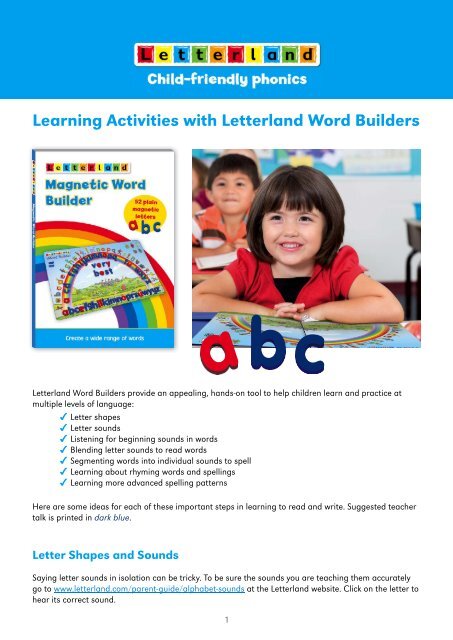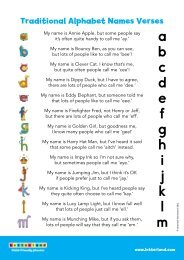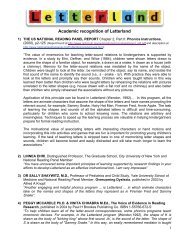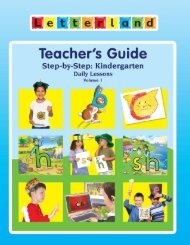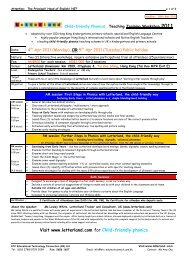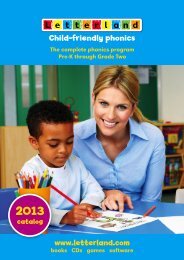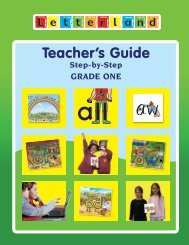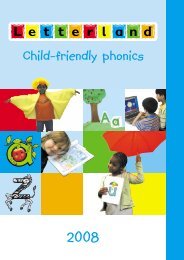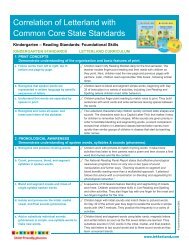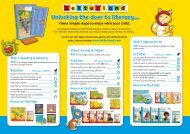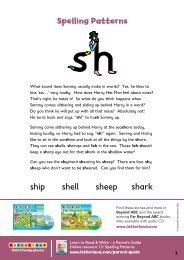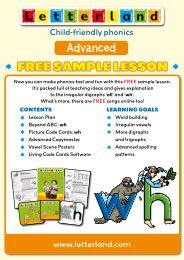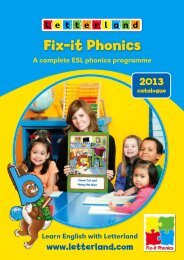to download a detailed instruction sheet for how to use ... - Letterland
to download a detailed instruction sheet for how to use ... - Letterland
to download a detailed instruction sheet for how to use ... - Letterland
- No tags were found...
You also want an ePaper? Increase the reach of your titles
YUMPU automatically turns print PDFs into web optimized ePapers that Google loves.
Learning Activities with <strong>Letterland</strong> Word Buildersabc<strong>Letterland</strong> Word Builders provide an appealing, hands-on <strong>to</strong>ol <strong>to</strong> help children learn and practice atmultiple levels of language: Letter shapes Letter sounds Listening <strong>for</strong> beginning sounds in words Blending letter sounds <strong>to</strong> read words Segmenting words in<strong>to</strong> individual sounds <strong>to</strong> spell Learning about rhyming words and spellings Learning more advanced spelling patternsHere are some ideas <strong>for</strong> each of these important steps in learning <strong>to</strong> read and write. Suggested teachertalk is printed in dark blue.Letter Shapes and SoundsSaying letter sounds in isolation can be tricky. To be sure the sounds you are teaching them accuratelygo <strong>to</strong> www.letterland.com/parent-guide/alphabet-sounds at the <strong>Letterland</strong> website. Click on the letter <strong>to</strong>hear its correct sound.1
Activity 1: Find My LetterLet’s play ‘Find my Letter’.How <strong>to</strong>: Place the 5 <strong>to</strong> 26 letters randomly around the board. Children match the magnetic letters <strong>to</strong>the <strong>Letterland</strong>ers. They can place them over the characters or just under them on the rainbow. Havethem name the <strong>Letterland</strong>er and say the sound as they place the letter, e.g. “Eddy Elephant, ĕ.”Support• If the child has not learned any <strong>Letterland</strong>ers, start with just a few plain letters on the board. Point <strong>to</strong>a <strong>Letterland</strong>er and tell them the character’s name and sound. The child then places the plain letteron the rainbow just below the character, and says the <strong>Letterland</strong>er’s name and sound. After placingfi ve or six letters, scramble them again and take turns replacing them and saying the <strong>Letterland</strong>er’sname and sound.• For a child who doesn’t know certain letters, ask him or her <strong>to</strong> point <strong>to</strong> them <strong>for</strong> you <strong>to</strong> say the<strong>Letterland</strong>er’s name and sound. Then the child repeats both the name and sound, and moves themagnetic letter in place below the matching <strong>Letterland</strong>er.• If children know the <strong>Letterland</strong>er but not the sound, help them <strong>to</strong> do the ‘Sounds Trick.’ Say the<strong>Letterland</strong>er’s name, start <strong>to</strong> say it again, but s<strong>to</strong>p at the fi rst sound, e.g. “Sammy Snake, sss.”• To help children learn the shapes and <strong>how</strong> <strong>to</strong> write them, have them trace the magnetic letter withtheir <strong>for</strong>efi nger, using the same starting-point and strokes as <strong>use</strong>d <strong>for</strong> handwriting (see HandwritingSongs audio CD.)Activity 2: Who says?Let’s play “Who says?” I’ll say the <strong>Letterland</strong>ers’ sounds and you tell me who says them.How <strong>to</strong>: Cover some or all of the <strong>Letterland</strong>ers on the board with their magnetic letters (or place themjust below the character on the rainbow). Say a sound and have the child repeat it, e.g. p. Then ask,Who says p? The child says the <strong>Letterland</strong>er’s name and pulls the letter down in<strong>to</strong> the sky area on theboard. End by counting <strong>how</strong> many letters the child has now done correctly, and give praise.Variations• Start with the letters in the sky area. Say the sounds, and have the child move them in<strong>to</strong> place on <strong>to</strong>pof the matching <strong>Letterland</strong>er.• Take turns. You say a sound, the child repeats it and moves the letter <strong>to</strong> cover the <strong>Letterland</strong>er. Thenreverse roles, so the child says a sound and you move the letter.• Point <strong>to</strong> a magnetic letter. The child says the sound and covers the <strong>Letterland</strong>er with it.Support• If the child has not yet learned <strong>to</strong> connect the sound with the character name, tell them <strong>to</strong> repeat thesound. Then ask, Who’s name are you starting <strong>to</strong> say? (e.g. “Mmmmmmunching Mike”). (This willwork best, at fi rst, with the letter sounds that can best be prolonged: a, e, f, h, l, m, n, o, r, s, u, v, w,and z. As soon as the child catches on, the same thing can be done with all the other letter sounds.2
Activity 3: What’s my sound?Now let’s pretend the magnetic letters are magic but<strong>to</strong>ns. When you press on them, they say theirsounds—only, like all <strong>Letterland</strong> magic, we have <strong>to</strong> make it work ourselves.How <strong>to</strong>: Place several letters around the rainbow with their <strong>Letterland</strong>ers. The child presses on eachletter and makes the sound. (This can be a good quick warm up be<strong>for</strong>e you do some of the blending andsegmenting exercises below.)Variation: Place the letters randomly on the magnetic board. Children press the letter, make the sound,and then move it in<strong>to</strong> its place on the rainbow. Or you and the child take turns pressing letters, sayingthe sounds and moving them.Beginning Sounds in WordsActivity 4: Who am I?Let’s play ‘Who am I?’ The <strong>Letterland</strong>ers like words that start with their sound. For example, Golden Girllikes <strong>to</strong> grown green things in her garden, and she has a goat and some geese <strong>for</strong> pets.How <strong>to</strong>: Place 5-26 letters on the rainbow below the corresponding <strong>Letterland</strong>er. Say, <strong>for</strong> example, I likegoing fi shing. Who am I? The child moves the letter f over the pic<strong>to</strong>gram and says, “Firefi ghter Fred.” Letthe child take turns saying, “I like_____. Who am I?” Then you fi nd the <strong>Letterland</strong>er.Activity 5: Beginning Sound BingoFor two players each with a Magnetic Word Builder board. Use with ‘Beginning Sound Pictures’ from theTeacher’s Guide CDs or any other set of a-z pictures. When you pick up a picture word that starts with a<strong>Letterland</strong>er’s sound, fi nd that magnetic letter and move it on <strong>to</strong>p of the character.How <strong>to</strong>: Shuffle the Beginning g Sound Picture cards and place in a pile face down between the twoplayers. Each child places a set of a-z letters randomly in the sky below their rainbow. The fi rst childtakes the <strong>to</strong>p card, says the word, says its beginning sound, and moves the letter in<strong>to</strong> place on <strong>to</strong>p of the<strong>Letterland</strong>er. Children take turns until both have covered all the <strong>Letterland</strong>ers.3
Activity 6: Blending Sounds <strong>to</strong> Read WordsMake it, Blend itThe <strong>Letterland</strong>ers love it when you make their sounds and blend them <strong>to</strong>gether <strong>to</strong> make some words.Let’s try it with this word.How <strong>to</strong>: Make one of the words from the Short Vowel Word Bank below. Have the child follow thesesteps <strong>to</strong> blend the sounds and read the word:Blending Steps1. Touch each letter and sayits sound.1.sss, ă, t2.sssăăă2. Slide your fi nger underthe fi rst two letters andsay the sounds withouts<strong>to</strong>pping between them.(blend)s a ts a t3. Touch the fi nal letter andsay the sound.3.t4 & 5.sssăăăt,sat4. Now slide your fi ngerunder all three letters andblend the three sounds.s a ts a t5. Say the word again.Then you or the child say a sentence or phrase with the word <strong>to</strong> make sure the meaning is unders<strong>to</strong>od.Next change one letter <strong>to</strong> make a new word. (See the sequence of words in the Word Banks below.)VariationRather than making the word <strong>for</strong> the child, say the separate sounds in the word and have the child buildit. For example, you say the sounds in hat, ‘h’…’a’…’t’ with a pa<strong>use</strong> between each sound. The child setsthe letters out in order and blends them <strong>to</strong> discover the word. Saying the sounds will work well with shortvowel words like those in Word Banks 1, 2 and 3.For children at a later stage, working with words such as in Word Banks 4, 5, 6 and 7, call out the letternames <strong>for</strong> the child <strong>to</strong> build the word. For example, if you want the child <strong>to</strong> make the word boat, youwould say bee, oh, aye, tee. The child lines up the letters and blends the word.SupportIf a child has difficulty blending without pausing between sounds, s<strong>how</strong> <strong>how</strong> <strong>to</strong> do one step at a time.Have the child imitate what you have done, then move on <strong>to</strong> the next step. If the child doesn’t catch onat fi rst, do a few words, and then try on another day. Children often surprise us by picking up an ideaafter a few tries, if we are patient and positive.As the child progressesOnce the children can blend the sounds easily, they may not need <strong>to</strong> say each sound separately be<strong>for</strong>eblending. Instead, they may be able <strong>to</strong> simply slide their fi nger beneath and quickly blend the soundswithout pausing between sounds.4
Activity 7: Segmenting Sounds <strong>to</strong> Spell WordsLet’s learn about word stretching The <strong>Letterland</strong>ers all love <strong>to</strong> say their sounds in words – but they saythem quickly, making it tricky <strong>to</strong> hear each one of them. If you want <strong>to</strong> spell a word, the best thing <strong>to</strong> dois <strong>to</strong> say the word slowly – stretch it out – and listen <strong>for</strong> the <strong>Letterland</strong>ers’ sounds.How <strong>to</strong>: Word Stretching. First pretend that you have a big rubber band wrapped around your handsholding them <strong>to</strong>gether. Put your palms and fi ngers <strong>to</strong>gether in front of you.Now let’s pretend we are slowly stretching that rubber band out. We have <strong>to</strong> go slowly beca<strong>use</strong> it is areally strong rubber band. Move your hands apart slowly <strong>to</strong> about your own shoulder width.Then we have <strong>to</strong> put our hands back <strong>to</strong>gether slowly and quietly beca<strong>use</strong> we are going <strong>to</strong> be listening <strong>for</strong>the <strong>Letterland</strong>ers’ sounds. Use your muscles <strong>to</strong> make sure you don’t clap your hands <strong>to</strong>gether.Next we are going <strong>to</strong> say a word very slowlywhile we stretch out our rubber band again.We are going <strong>to</strong> stretch out the sounds inthe word while we slowly move our handsapart. Let’s start with the word sip, like asmall drink of water. Say, sip… Now, let’ssay and stretch the word with our rubberband, ssssssiiiiiiiip. (Prolong all but the lastsound ‘p’ which cannot be stretched).sipsssssiiiiiiiipPractice stretching the word sip a few times.Now let’s stretch sip out again, but we aregoing <strong>to</strong> s<strong>to</strong>p as soon as we’ve made thefi rst sound. (Stretch the word by movingyour hands slightly apart as you say, ssss.)sss,Sammy SnakeWho’s sound did you hear?... Yes, SammySnake says ‘ssss’. So put his letter in placefi rst. (Child moves s in<strong>to</strong> the sky on themagnetic board.)Now let’s stretch sip a little farther andsee if we can ‘jiggle out’ the middle sound.Pull your hands apart a bit further saying,Ssssiiii. Then jiggle you hands in smallback-and-<strong>for</strong>th movements as you repeatthe vowel sound, iii…iii…i. Who says thatsound?... Yes, Impy Ink. (Child places the iafter the letter s.)Let’s stretch sip one more time and see ifwe can hear the last sound. Pull your handsslowly apart and emphasize the last sound,sssssiiiiip. (Jiggle you hands back and<strong>for</strong>th at shoulder width this time, while yourepeat the fi nal whispered sound, p…p…p.Who says ‘p’?... Yes, Peter Puppy. (Childmoves the last letter in<strong>to</strong> place <strong>to</strong> spell sip.)ssssiiii...i...i...,Impy Inksssiiip...p...p,Peter Puppy5
Once children have learned the word stretching technique, follow these steps <strong>for</strong> spelling each word:Segmenting and Spelling StepsThe teacher or parent says the word, <strong>use</strong>s it in a brief sentence, and repeats the word. Then the child:1. Repeats the word.2. Stretches the whole word.3. Starts <strong>to</strong> stretch the word again and jiggles out each sound.4. Makes the word on the magnetic board.5. Blends the word by sliding a fi nger beneath <strong>to</strong> read it and <strong>to</strong> check the spelling.Leave the previous word in place, and call out the next word which you have chosen from one of theWord Banks below beca<strong>use</strong> it only differs by one letter from the previous word. Child follows steps 1-5with the new word.s ips i pBlending and Segmenting Activity VariationsChildren in pairs Give one child a word list <strong>to</strong> call out the fi rst three words, one at a time, <strong>to</strong> a secondchild who builds the words. Then the second child calls out the next three words <strong>for</strong> the fi rst child <strong>to</strong>build, etc.Make-a-rhyme: Make a word that has many rhyming words with the same spelling pattern (e.g.pet, net, set, let, bet, wet). Have the child read the word. Then the child makes a rhyming word bychanging the fi rst letter. If the child makes make a nonsense word, have him or her pronounce it. Thenhave the child keep changing the fi rst letter until they make a real word. Then you change the word <strong>to</strong>make another rhyming word and so on back and <strong>for</strong>th. List the real words you make <strong>for</strong> the child <strong>to</strong> readthem all when you are fi nished. Children can also play this way in pairs. They can compare the numberof real words they make with other pairs of children.Change-a-word: Make a word <strong>for</strong> the child <strong>to</strong> read. Then the child changes any one letter <strong>to</strong> make anew word. They must change red letters (vowels) <strong>to</strong> other red letters, and blue letters (consonants) <strong>to</strong>other blue letters. They may try several changes until they make a real word. Then you change one letter<strong>to</strong> make another word and so on. List each real word as you make it <strong>for</strong> reading later. For extra practice,each time you do another word, read <strong>to</strong>gether all the words listed so far.Quick Words: Place on the board 6 <strong>to</strong> 10 letters. Include at least two vowels. Children make wordsusing the letters. Write down each real word they make and then count <strong>to</strong> see <strong>how</strong> many they made. Youcould time them and see <strong>how</strong> many words they can make in three minutes. Children could work in pairs<strong>to</strong> make and write the words.6
Using the Word BanksThe Word Banks 1–7 are listed from beginning <strong>to</strong> a more advanced level. You can start with any word inthe list and move from left <strong>to</strong> right. Tell the child that they will only need <strong>to</strong> change one letter at a time(or occasionally two or three). Be selective, choosing 5 <strong>to</strong> 10 words from these sequences <strong>for</strong> practice.Move on <strong>to</strong> more advanced words as soon as you judge the child <strong>to</strong> be ready.VariationTurn a bug in<strong>to</strong> a cat: Choose a word <strong>to</strong> start with. Then look across the list fi ve <strong>to</strong> ten words alongand tell the child, <strong>for</strong> example, that they will be turning a bug in<strong>to</strong> a cat. Then follow the usual steps <strong>to</strong>build each word from bug <strong>to</strong> cat. You can <strong>use</strong> this activity <strong>for</strong> blending (where you make the words, or<strong>for</strong> spelling (call out the words <strong>for</strong> the child <strong>to</strong> build).Word Bank 1: Short Vowelssad → sap sip sit sat mat man pan pin pigbig wig wag bag bug rug rag rat cat cancap lap lip dip did dad had hat fat fi tfi n fan ran tan ten hen pen pet jet netwet yet yes us bus bun fun run rub tubtug tag tap tip tin win kin kit lit lidled leg log dog jog job jot lot let betbed bid but nut not hot hop <strong>to</strong>p mop mapmat met yet yesWord Bank 2:Short Vowels with Consonant Digraphback bath path pack peck pick pill will well shelltell ten then than that chat chap chop shop shipchip chin thin thing wing ring rang hang ban henhem hum them when whip whiz with math path bathWord Bank 3:Short Vowels with Adjacent Consonants (Blends)nap snap sap slip sip tip trip trap tap capcab crab grab grass glass glad lad lap fl ap fl ipfl op fl oss loss lost list last blast black back sacksnack stack tack track trick tick stick s<strong>to</strong>ck s<strong>to</strong>p step7
Word Bank 4: Magic etap tape take tack back bake lake late gate gotnot note vote cone bone bin fi n fi ne line pinepane pan can cab cub cube tube tub tuck trucktrack trade grade grave brave pave plane plan fl ap fl akeWord Bank 5: The Vowel Men Out Walkingtea sea seat neat sneak speak peak heap cheek weekweed wheel steel feel foal coal coat goat groan grainsprain brain rain train true glue blue clue clean claimaim ail pail fail jail mail main may day layplay loan moan moat boatWord Bank 6: The Vowel Stealersart dart dark park spark mark smart start star s<strong>to</strong>remore shore core <strong>for</strong> born <strong>to</strong>rn north horn corn doorfl oor letter better wetter winter never ever over other brothermother mister sister summer number lumber slumber hummer hammer stammerWord Bank 7: Other Vowel Spellings and Soundslow slow blow glow grow grown know snow s<strong>how</strong> sightnight light right fi ght fright bright boo boot boom broomroom zoom zoo <strong>to</strong>o <strong>to</strong>ol fool food foot <strong>to</strong>ok lookhook shook s<strong>to</strong>od saw law claw draw paw pa<strong>use</strong> saucefault fl ew blew new knew grew drew cloud count soundfound frown crown clown now <strong>how</strong> cow coin join jointmoist noise point oil boil boy joy <strong>to</strong>y air chairfair stair pair ear dear fear clear near spear hear8


